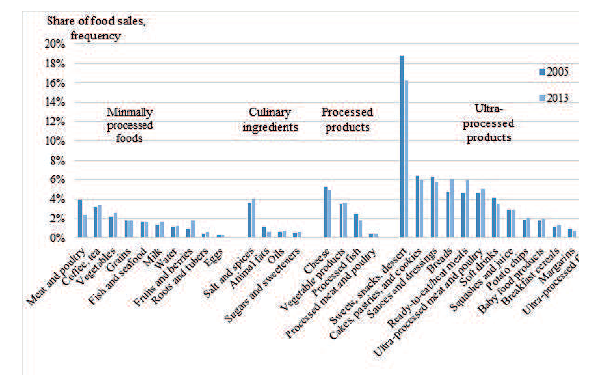Ultraprocessed foods in Norway: an analysis of consumer purchase and expenditure
Ultra-processed foods are contributing to the global obesity epidemic
The consumption of processed foods is one of the major factors contributing to the global obesity epidemic1. A new framework for classifying food based on extent of industrial processing was introduced in 20092, and divides food and food products into:
- minimally processed (non-processed fruit, vegetables, legumes, meat, milk, eggs, grains, flours etc, and water);
- culinary ingredients (animal fats, plant oils, sugar, salt);
- processed (foods preserved through salting, drying, fermenting, tinning); or
- ultra-processed (mixed products such as ready-to-eat meals, snacks, and soft drinks).
Minimally processed foods and culinary ingredients are the basis for homemade meals and, together with processed foods, make up the basis of traditional diets. The increased consumption of ultra-processed products, however, is directly linked to obesity3. These products dominate diets in high-income countries and are penetrating markets of the poorest countries4,5.
Study design: food sales data in Norway
This study assessed food sales data to identify the degree to which the Norwegian population is buying ultra-processed foods over lessprocessed food for preparing meals at home. We used data from food retail in Norway collected by Statistics Norway in September 2005 (n=150) and 2013 (n=170). Data consisted of 795,306 barcode scans of food item purchases, which provided information on type of food purchased, price paid, geographical region and retail type. The frequency of purchase and expenditure for each of the four food groups described above were analyzed.
Sweets, snacks and dessert are purchased more than five times as often as non-processed vegetables
We found that both in 2005 and 2013 ultra-processed products dominated food purchases and expenditure in Norway: 59 % of food items purchased and 49 % of food expenditure was ultra-processed foods. All minimally processed foods combined accounted for only 17 % of purchases and 33 % of expenditure on food.
Dividing food purchases into sub-groups showed that Norwegians spent less on and purchased less frequently minimally processed meat and poultry, fi sh and seafood, vegetables, potatoes, and fruit and berries compared to the respective processed and ultra-processed versions of these foods (figure 1).
Sweets, snacks and desserts were the most frequently purchased food items, accounting for 16 % of purchases in 2013. In comparison, minimally processed meat and poultry accounted for 2 % of purchases, and vegetables, roots and tubers accounted for 3 %. Only 2 % of purchases were minimally processed fruit and berries.
Between 2005 and 2013, food sales changed marginally, but in favor of minimally processed foods and in disfavor of ultra-processed foods. The largest relative increases in purchases and food expenditure were found for minimally processed fruit and vegetables, and for ready-to eat/heat meals. Sales of sweet ultra-processed products decreased slightly (- 1% point). The changes towards a less processed food purchase pattern was considerably more expressed in the capital city, Oslo, than in the rest of the country.
Increases in sales of fruit and vegetables related to higher health awareness
Ultra-processed foods account for 60 % of purchases and 50 % of food expenditure in Norway, based on the data analyzed in this study. Sweet ultra-processed products alone accounted for every third food item purchase and more than a fifth of food expenditure. The high share of ultra-processed products in the Norwegian diet is in line with findings from studies in other high-income countries6. If nutrient profi les of such diets in Norway are similar to those in Canada, for example, a reduction in the consumption of ultra-processed foods is necessary for the prevention of obesity and noncommunicable diseases. Of special concern is the high intake of sugar.
The reduction in share of food sales for ultra-processed products, and increased sales of fresh fruit and vegetables are in line with documented increases in health awareness among Norwegian consumers7.
Norwegian food and health policies rely on dietary recommendations, labelling, encouraging food reformulation, and food industry selfregulation of marketing8. This study recommends stronger focus on policies aiming at reducing intake of ultra-processed products and facilitating access (including economic) to less-processed foods.

Figure 1: Food sales: share of frequency of purchase for food groups in September 2005 and September 2013
References
1. World Health Organization. Diet, nutrition and the prevention of chronic diseases. Joint
WHO/FAO expert consultation. Technical report Series no. 916. Geneva: WHO; 2003.
2. Monteiro CA. Nutrition and health. The issue is not food, nor nutrients, so much as
processing. Public health nutrition. 2009;12(05):729-31.
3. Louzada MLC, Martins APB, Canella DS, Baraldi LG, Levy RB, Claro RM, et al.
Consumption of ultra-processed products is associated with obesity in adolescents and
adults in Brazil. Ann Nutr Metab 2013;63 (suppl. 1):199-200.
4. Monteiro CA, Moubarac JC, Cannon G, Ng SW, Popkin BM. Ultra-processed products
are becoming dominant in the global food system. Obes Rev. 2013;14:21-8.
5. Stuckler D, McKee M, Ebrahim S, Basu S. Manufacturing epidemics: the role of global
producers in increased consumption of unhealthy commodities including processed foods,
alcohol, and tobacco. PLoS Med. 2012;9(6):e1001235. doi:10.1371/journal.pmed.
6. Moubarac JC, Martins AP, Claro R, Levy R, Cannon G, Monteiro CA. Consumption of
ultra-processed foods and likely impact on human health. Evidence from Canada. Public
health nutrition. 2012;16(12):2240-8.
7. Bugge AB. Hva kjennetegner forbrukernes preferanser, prioriteringer og praksiser knyttet
til fi sk og grønnsaker. In: Bugge AB, editor. HealthMeal Hvordan nå de ernæringsmessige
målsetningene om økt forbruk av fi sk og grønnsaker? Oslo: SIFO; 2015.
8. Meld.st. 34 (2012-2013). Folkehelsemeldingen: God helse – felles ansvar. Oslo:
Regjeringen; 2013.
